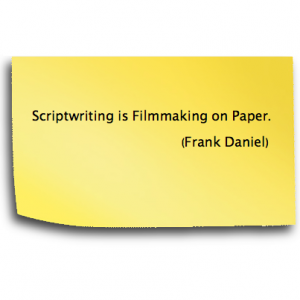Narration techniques

Variation and Escalation
Variation and escalation are the most used dramatic narrative concepts. Variation sets up expectations. This expectation is then topped in form of escalation. This concept is similar to the ‘repetition and crescendo’ technique creating a comic effect. Likewise the theme is continuously modified in the course of the film.
Planting – Pay Off
A basic dramatic narrative technique is the seemingly casual distribution of specific information. This visual, verbal or tonal information initially stands for itself. Only later, in a new context, this information takes on greater significance for the plot. The recognition of something known in a new light triggers a negative or positive realisation: a shock or a feeling of happiness. This moment of paying off represents a kind of punch line. This concept of ‘planting and pay-off’ is used to get the audience involved. When used in a subtle, unconscious way it is important to make the audience forget the information they just received. To deliberately create suspense or to set up information very clearly one may also use frequent ‘planting’. ‘To sow and to harvest’ means: to disguise and to reveal, to make a promise and to honour a promise, to fail to recognize and to understand, to imply and to disclose.
Foreshadowing is a special form of planting:
Foreshadowing
Foreshadowing is the visual establishing of an unsettling, ominous mood at the beginning of the film: something telling us that something horrible is about to happen. This mood is often caught in a landscape establishing shot. Foreshadowing is a non-verbal form of planting, which is paid off at a later moment in the film. This tool is not to be confused with a flash-forward.
Preparation – Resonance/Aftermath
Important turning points, recognitions / revelations, events or decisions often need preparation and space for resonance. Preparation is necessary to set up the prerequisites for a subsequent crucial plot element. Space and time for resonance is important for the (emotional) digestion of what just happened or to relax after a period of tension.
Revelation / Recognition
When a character is confronted with existential information, realisation or understanding this is called a recognition / anagnorisis. When this affects the audience it is called a revelation. Bevor the moment of revelation the audience often experiences a feeling of suspense. The revelation is therefore self-affecting.
Self-affect / Shared-affect
A self-affect only affects the audience while the characters are still clueless (i.e. suspense). This narrative tool is also called dramatic irony. The shared-affect touches the character as well as the audience at the same moment in time (i.e. surprise).
Contrasts
Working with contrasts is a key dramatic tool, e.g. to create humour or irony, to shape a theme or to set up a conflict. The use of contrasts is furthermore very effective when constructing characters, e.g. to establish the extent of the hero’s dramatic fall. The dualism of protagonist and antagonist, the dialectics of action and reaction, the reversal of happiness into misery or the switch between tension and release are all based on the effect of contrast. But contrast may also be used when establishing settings or designing the momentum (e.g. smash cut). Contradictions, opposites, irrationality, inappropriateness, surprise, breaking or irritations all trigger contrasts.


Comments are closed.